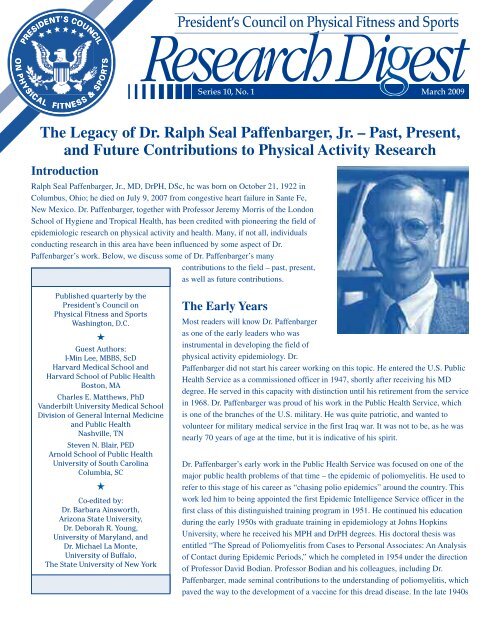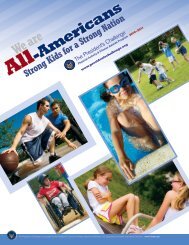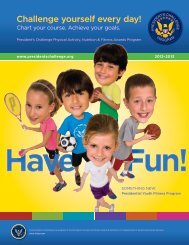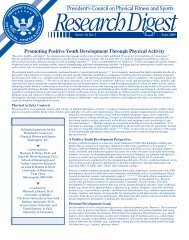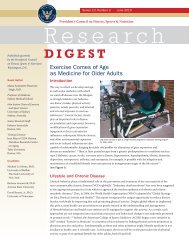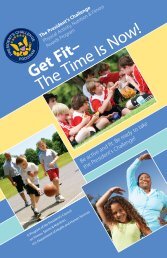The Legacy of Dr. Ralph Seal Paffenbarger, Jr - The President's ...
The Legacy of Dr. Ralph Seal Paffenbarger, Jr - The President's ...
The Legacy of Dr. Ralph Seal Paffenbarger, Jr - The President's ...
You also want an ePaper? Increase the reach of your titles
YUMPU automatically turns print PDFs into web optimized ePapers that Google loves.
<strong>The</strong> <strong>Legacy</strong> <strong>of</strong> <strong>Dr</strong>. <strong>Ralph</strong> <strong>Seal</strong> <strong>Paffenbarger</strong>, <strong>Jr</strong>. – Past, Present,<br />
and Future Contributions to Physical Activity Research<br />
Introduction<br />
ResearchDi est<br />
Series 10, No. 1 March 2009<br />
<strong>Ralph</strong> <strong>Seal</strong> <strong>Paffenbarger</strong>, <strong>Jr</strong>., MD, <strong>Dr</strong>PH, DSc, hc was born on October 21, 1922 in<br />
Columbus, Ohio; he died on July 9, 2007 from congestive heart failure in Sante Fe,<br />
New Mexico. <strong>Dr</strong>. <strong>Paffenbarger</strong>, together with Pr<strong>of</strong>essor Jeremy Morris <strong>of</strong> the London<br />
School <strong>of</strong> Hygiene and Tropical Health, has been credited with pioneering the field <strong>of</strong><br />
epidemiologic research on physical activity and health. Many, if not all, individuals<br />
conducting research in this area have been influenced by some aspect <strong>of</strong> <strong>Dr</strong>.<br />
<strong>Paffenbarger</strong>’s work. Below, we discuss some <strong>of</strong> <strong>Dr</strong>. <strong>Paffenbarger</strong>’s many<br />
contributions to the field – past, present,<br />
as well as future contributions.<br />
Published quarterly by the<br />
President’s Council on<br />
Physical Fitness and Sports<br />
Washington, D.C.<br />
Guest Authors:<br />
I-Min Lee, MBBS, ScD<br />
Harvard Medical School and<br />
Harvard School <strong>of</strong> Public Health<br />
Boston, MA<br />
Charles E. Matthews, PhD<br />
Vanderbilt University Medical School<br />
Division <strong>of</strong> General Internal Medicine<br />
and Public Health<br />
Nashville, TN<br />
Steven N. Blair, PED<br />
Arnold School <strong>of</strong> Public Health<br />
University <strong>of</strong> South Carolina<br />
Columbia, SC<br />
Co-edited by:<br />
<strong>Dr</strong>. Barbara Ainsworth,<br />
Arizona State University,<br />
<strong>Dr</strong>. Deborah R. Young,<br />
University <strong>of</strong> Maryland, and<br />
<strong>Dr</strong>. Michael La Monte,<br />
University <strong>of</strong> Buffalo,<br />
<strong>The</strong> State University <strong>of</strong> New York<br />
President’s Council on Physical Fitness and Sports<br />
<strong>The</strong> Early Years<br />
Most readers will know <strong>Dr</strong>. <strong>Paffenbarger</strong><br />
as one <strong>of</strong> the early leaders who was<br />
instrumental in developing the field <strong>of</strong><br />
physical activity epidemiology. <strong>Dr</strong>.<br />
<strong>Paffenbarger</strong> did not start his career working on this topic. He entered the U.S. Public<br />
Health Service as a commissioned <strong>of</strong>ficer in 1947, shortly after receiving his MD<br />
degree. He served in this capacity with distinction until his retirement from the service<br />
in 1968. <strong>Dr</strong>. <strong>Paffenbarger</strong> was proud <strong>of</strong> his work in the Public Health Service, which<br />
is one <strong>of</strong> the branches <strong>of</strong> the U.S. military. He was quite patriotic, and wanted to<br />
volunteer for military medical service in the first Iraq war. It was not to be, as he was<br />
nearly 70 years <strong>of</strong> age at the time, but it is indicative <strong>of</strong> his spirit.<br />
<strong>Dr</strong>. <strong>Paffenbarger</strong>’s early work in the Public Health Service was focused on one <strong>of</strong> the<br />
major public health problems <strong>of</strong> that time – the epidemic <strong>of</strong> poliomyelitis. He used to<br />
refer to this stage <strong>of</strong> his career as “chasing polio epidemics” around the country. This<br />
work led him to being appointed the first Epidemic Intelligence Service <strong>of</strong>ficer in the<br />
first class <strong>of</strong> this distinguished training program in 1951. He continued his education<br />
during the early 1950s with graduate training in epidemiology at Johns Hopkins<br />
University, where he received his MPH and <strong>Dr</strong>PH degrees. His doctoral thesis was<br />
entitled “<strong>The</strong> Spread <strong>of</strong> Poliomyelitis from Cases to Personal Associates: An Analysis<br />
<strong>of</strong> Contact during Epidemic Periods,” which he completed in 1954 under the direction<br />
<strong>of</strong> Pr<strong>of</strong>essor David Bodian. Pr<strong>of</strong>essor Bodian and his colleagues, including <strong>Dr</strong>.<br />
<strong>Paffenbarger</strong>, made seminal contributions to the understanding <strong>of</strong> poliomyelitis, which<br />
paved the way to the development <strong>of</strong> a vaccine for this dread disease. In the late 1940s
and early 1950s it was widely believed that we were a long<br />
way from solving the polio problem, if ever. However, <strong>Dr</strong>.<br />
Jonas Salk’s discovery <strong>of</strong> the polio vaccine, and the classical<br />
epidemiological studies by Bodian, <strong>Paffenbarger</strong>, and others<br />
led to the first successful polio vaccine trial in the mid-<br />
1950s. <strong>Dr</strong>. <strong>Paffenbarger</strong> published numerous papers on<br />
infectious disease, including the classical papers on<br />
poliomyelitis. 1, 4, 5, 20, 41, 43, 45, 46, 53-55, 68<br />
<strong>Dr</strong>. <strong>Paffenbarger</strong> continued his work on infectious diseases<br />
during 1955-1958 while he was assigned to the Robert A.<br />
Taft Sanitary Engineering Center in Cincinnati. He also<br />
turned his attention to parapartum mental illnesses,<br />
completing important research and publishing several papers<br />
on the topic. 42, 44, 51, 52<br />
<strong>Dr</strong>. <strong>Paffenbarger</strong>’s assignment in the Public Health Service<br />
took him to the National Heart Institute (now the National<br />
Heart, Lung, and Blood Institute) in 1958. Although he<br />
continued research on topics such as mental illnesses,<br />
suicide, and accidental death, he soon began working on<br />
projects to help understand the new major public health<br />
problem <strong>of</strong> cardiovascular disease. He was one <strong>of</strong> the early<br />
investigators involved in the Framingham Heart Study, which<br />
laid the foundation for a great deal <strong>of</strong> cardiovascular disease<br />
epidemiology that followed over the next decades. It was<br />
during this time that <strong>Dr</strong>. <strong>Paffenbarger</strong> began to develop an<br />
interest in the possible role <strong>of</strong> physical inactivity in the<br />
development <strong>of</strong> cardiovascular disease. He would <strong>of</strong>ten talk<br />
about those early days and his conversations with individuals<br />
such as <strong>Dr</strong>. Paul Dudley White, the famous Boston<br />
cardiologist, and <strong>Dr</strong>. James Watt, the first Director <strong>of</strong> the<br />
National Heart Institute. He became aware <strong>of</strong> the first<br />
systematic research on physical activity and coronary heart<br />
disease conducted by Pr<strong>of</strong>essor Jeremy (“Jerry”) Morris <strong>of</strong><br />
London, published shortly before <strong>Dr</strong>. <strong>Paffenbarger</strong> joined the<br />
National Heart Institute. He later met Pr<strong>of</strong>essor Morris, and<br />
the two became great friends, and this friendship persisted<br />
throughout <strong>Dr</strong>. <strong>Paffenbarger</strong>’s life.<br />
<strong>Dr</strong>. <strong>Paffenbarger</strong> established two major epidemiological<br />
studies that led to the outstanding work on physical activity<br />
and cardiovascular disease during the 1960s: the College<br />
Alumni Health Study (including alumni from Harvard<br />
University [the Harvard Alumni Health Study] and the<br />
University <strong>of</strong> Pennsylvania) and the San Francisco<br />
Longshoremen Study. Both studies led to first-<strong>of</strong>-a-kind<br />
reports on topics such as physical activity and stroke, 49<br />
2<br />
hypertension, 59 diabetes, 17 and longevity. 47 His contributions<br />
to physical activity and health are discussed in more detail<br />
below.<br />
<strong>Dr</strong>. <strong>Paffenbarger</strong>’s Honors<br />
<strong>Dr</strong>. <strong>Paffenbarger</strong> received many awards and honors over the<br />
years. <strong>The</strong>y take three pages in his CV, and are too numerous<br />
to list here. Some <strong>of</strong> the awards most relevant to the physical<br />
activity epidemiology field are:<br />
• <strong>The</strong> first International Olympic Committee Prize for<br />
contributions to sports medicine, shared with his friend<br />
Pr<strong>of</strong>essor Jerry Morris. <strong>The</strong> prize was awarded in 1996 as<br />
part <strong>of</strong> the Olympic Games in Atlanta. <strong>The</strong> Gold Medal<br />
that accompanied this prize is displayed in the<br />
headquarters <strong>of</strong> the American College <strong>of</strong> Sports Medicine<br />
in Indianapolis.<br />
• Honorary Order <strong>of</strong> the Horse Collar Knights, University<br />
<strong>of</strong> Kuopio, Finland. This order was established many<br />
years ago, and some <strong>of</strong> the world’s most distinguished<br />
exercise scientists have been recipients. <strong>Dr</strong>. <strong>Paffenbarger</strong><br />
always enjoyed going to the Puijo Symposium in Kuopio,<br />
where this honor was bestowed. <strong>The</strong> 20th Puijo<br />
Symposium will be held in June 2009, with a competition<br />
for the <strong>Ralph</strong> S. <strong>Paffenbarger</strong>, <strong>Jr</strong>. awards for the best<br />
scientific posters.<br />
• American College <strong>of</strong> Sports Medicine (ACSM)—Citation<br />
Award and the ACSM’s highest award, <strong>The</strong> Honor Award,<br />
were both won by <strong>Dr</strong>. <strong>Paffenbarger</strong>. He also delivered the<br />
1988 Wolffe Lecture, which is the premier lecture at the<br />
ACSM annual meeting.<br />
Influence on Present Contributions<br />
<strong>Dr</strong>. <strong>Paffenbarger</strong>’s contributions to epidemiologic research<br />
on physical activity and health are many and the ideas he<br />
initiated continue to impact the field today. Some <strong>of</strong> his ideas<br />
which have influenced contemporaneous research may be<br />
grouped into three themes carrying important public health<br />
implications – first, that physical activity has a wide range <strong>of</strong><br />
effects for chronic disease prevention; second, that physical<br />
activity has health effects among many subgroups; and third,<br />
that dose-response relationships between physical activity<br />
and health are important.<br />
Wide range <strong>of</strong> health benefits from physical<br />
activity for chronic disease prevention<br />
When <strong>Dr</strong>. <strong>Paffenbarger</strong> initiated the College Alumni Health<br />
Study in the early 1960s, it was to investigate the predictors<br />
<strong>of</strong> coronary heart disease. 26 However, the study evolved to
ecome one that primarily focused on a risk factor – physical<br />
inactivity – as opposed to focusing on a specific disease<br />
outcome<br />
To that end, <strong>Dr</strong>. <strong>Paffenbarger</strong> developed a method <strong>of</strong><br />
assessing physical activity via questionnaire, which has been<br />
extensively tested and shown to be reliable and valid 26<br />
(including validation against doubly-labeled water, 6 a gold<br />
standard for measuring energy expenditure) for large<br />
population studies. Using this questionnaire, he examined the<br />
associations <strong>of</strong> physical activity with a wide range <strong>of</strong><br />
outcomes, including longevity, 29, 47, 48 coronary heart<br />
disease, 34, 58 stroke, 32, 56 type 2 diabetes, 17 hypertension, 59<br />
various site-specific cancers, 31, 33 Parkinson’s disease, 36 peptic<br />
ulcer, 57 and depression and suicide. 50<br />
Contemporaneous research has continued on this theme,<br />
investigating the many health benefits associated with<br />
physical activity. In particular, there has been a great deal <strong>of</strong><br />
interest in cancer prevention and survival 65 since cancer is a<br />
major cause <strong>of</strong> death in the world, and in preventing or<br />
delaying neurodegenerative diseases, which have been<br />
increasing in incidence commensurate with longer human<br />
lifespan today. 22<br />
An example <strong>of</strong> a study examining the role <strong>of</strong> physical<br />
activity in cancer prevention comes from the European<br />
Prospective Investigation into Cancer and Nutrition (EPIC)<br />
investigating pancreatic cancer, 2 which has been less well<br />
studied than colon, breast and prostate cancers. 27 Among the<br />
postulated mechanisms for an inverse relation between<br />
physical activity and risk <strong>of</strong> this cancer are the beneficial<br />
effects <strong>of</strong> exercise on insulin and glucose sensitivity, which<br />
are related to pancreatic cancer risk. 27 EPIC investigators<br />
reported a non-significant reduction in pancreatic cancer risk<br />
(relative risk, RR, =0.82; 95% confidence interval, CI, 0.50-<br />
1.35) with physical activity. 2 Other studies have reported<br />
inconsistent associations, and further research is needed. 27<br />
With regard to neurodegenerative diseases, several<br />
mechanisms may be responsible for the protective effect <strong>of</strong><br />
physical activity on the brain, including improvement <strong>of</strong><br />
cerebrovascular circulation, increased production <strong>of</strong><br />
neurotropic substances, and decreased age-related neuronal<br />
loss and decline in spontaneous motor activity. 36 While<br />
epidemiologic data on the relation between physical activity<br />
and neurodegenerative diseases are limited, some studies<br />
have reported inverse associations. 22 For example, a Finnish<br />
3<br />
study observed rates <strong>of</strong> dementia and Alzheimer’s disease<br />
among regularly active persons that were less than half those<br />
among inactive persons (RR=0.48 [0.25-0.91] and 0.38<br />
[0.17-0.85], respectively). 61<br />
Health benefits <strong>of</strong> physical activity observed<br />
in many subgroups<br />
A second theme emerging from <strong>Dr</strong>. <strong>Paffenbarger</strong>’s research<br />
is the investigation <strong>of</strong> whether the health benefits <strong>of</strong> physical<br />
activity extend to different subgroups <strong>of</strong> individuals. 58 In his<br />
early research, the examination <strong>of</strong> subgroups was probably<br />
motivated by the desire to assess confounding – that is,<br />
physically active individuals also are likely to possess other<br />
healthy habits and a better health pr<strong>of</strong>ile. 28 Because <strong>of</strong> these<br />
potential differences, the question arises as to whether it is<br />
physical activity that is responsible for the lower rates <strong>of</strong><br />
chronic disease, or whether the lower rates are due to other<br />
associated health characteristics.<br />
Today, researchers have statistical methods to control for<br />
confounding, but continue to examine subgroups <strong>of</strong><br />
individuals to investigate whether physical activity can<br />
benefit the health <strong>of</strong>, for example, men and women; older<br />
and younger persons; white individuals and persons <strong>of</strong> other<br />
racial/ethnic groups; leaner and heavier persons; and persons<br />
without and with a history <strong>of</strong> cardiovascular disease. 19, 62, 64<br />
One topic kindling continued debate is the relation <strong>of</strong><br />
physical activity or fitness to health among subgroups <strong>of</strong><br />
persons with differing adiposity (i.e., the “fit or fat” debate).<br />
Some studies suggest that physical activity/fitness can<br />
completely obliterate the increased risk <strong>of</strong> all-cause mortality<br />
or cardiovascular disease mortality associated with increased<br />
adiposity. 25 Other studies, however, observe that physical<br />
inactivity and increased adiposity each appears to be an<br />
independent risk factor, <strong>of</strong> about equal magnitude, that does<br />
not cancel the deleterious effect <strong>of</strong> the other risk factor. 30, 67<br />
For type 2 diabetes, however, the data have been more<br />
consistent in showing that increased adiposity is a strong risk<br />
factor, and that physical activity or fitness does not remove<br />
the increased risk associated with increased adiposity. 63, 66<br />
Dose-response relationship between physical<br />
activity and health<br />
<strong>The</strong> dose-response relationship between physical activity and<br />
health is one that has engendered a large amount <strong>of</strong> interest<br />
recently because <strong>of</strong> its importance for public health<br />
recommendations. 23, 65 Issues related to the dose-response<br />
relationship include: 26 what kinds (intensities) <strong>of</strong> activity are
NUMBER WITH HEART ATTACK<br />
PER 10,000 PERSON-YEARS OBSERVATION<br />
60<br />
40<br />
20<br />
00<br />
500 500-<br />
999 1000-<br />
1999<br />
HEART ATTACKS:<br />
2000-<br />
2999<br />
3000-<br />
3999<br />
needed? How much activity (total activity, frequency,<br />
duration)? What patterns <strong>of</strong> activity? What is the shape <strong>of</strong> the<br />
dose-response curve?<br />
<strong>Dr</strong>. <strong>Paffenbarger</strong> had already begun study <strong>of</strong> dose-response<br />
relationships in detailed fashion several decades ago. In his<br />
landmark study published in 1978, 58 he noted an inverse<br />
dose-response relationship between physical activity and first<br />
heart attack (Figure 1). This detailed analysis allowed<br />
observation <strong>of</strong> the following: (a) the lack <strong>of</strong> a “threshold” for<br />
a benefit <strong>of</strong> physical activity; (b) the steep decline in the<br />
early part <strong>of</strong> the curve, followed by less steep declines (i.e., a<br />
curvilinear shape to the dose-response curve, indicating large<br />
reductions in risk with small amounts <strong>of</strong> physical activity<br />
between 0 and
indicator <strong>of</strong> the number <strong>of</strong> actively working investigators<br />
who have assimilated his body <strong>of</strong> work into their own<br />
scientific perspectives. Thus, one <strong>of</strong> <strong>Dr</strong>. <strong>Paffenbarger</strong>’s key<br />
influences on the future <strong>of</strong> physical activity epidemiology is<br />
his role in helping facilitate the establishment <strong>of</strong> a large and<br />
growing cohort <strong>of</strong> investigators who study physical activity<br />
and health, and who are working to address the present day<br />
challenges to this field. <strong>The</strong>se challenges include the need to<br />
add to the evidence base demonstrating the many health<br />
benefits <strong>of</strong> an active lifestyle by continuing to identify new<br />
associations between activity behaviors and health outcomes,<br />
by gathering additional information on suspected<br />
associations, and by refining our understanding <strong>of</strong> the doseresponse<br />
relationship between physical activity and disease<br />
outcomes with established associations.<br />
We face these challenges in a society that, in technological<br />
terms, has advanced rapidly in the last fifty years, and these<br />
changes have quietly reduced the level <strong>of</strong> physical exertion<br />
required each day to navigate life at home, work, school, and<br />
during leisure time, while at the same time encouraging us to<br />
spend an increasing amount <strong>of</strong> time in purely sedentary<br />
behaviors.<br />
<strong>Dr</strong>. <strong>Paffenbarger</strong> encountered a similar type <strong>of</strong> temporal<br />
change in work activity in his study <strong>of</strong> longshoremen. 40<br />
Occupational physical activity was once a major contributor<br />
to daily energy expenditure for those in the work force and<br />
the opportunity to contrast highly active with more sedentary<br />
occupational groups <strong>of</strong>fered <strong>Dr</strong>. <strong>Paffenbarger</strong> and others a<br />
unique natural experiment with which to study the health<br />
effects <strong>of</strong> physical activity. However, during the<br />
longshoremen’s study, technological advances on the docks<br />
dramatically reshaped the physical demands <strong>of</strong> their<br />
workplace. At the beginning <strong>of</strong> the study (1951-60), 40% <strong>of</strong><br />
longshoremen engaged in heavy work that proved to be<br />
protective for coronary heart disease mortality, but this<br />
declined to 15% by 1961-70, and only 5% by 1972. 40 This<br />
led <strong>Dr</strong>. <strong>Paffenbarger</strong> to make the statement: 40<br />
If high energy output is protective, workers thus<br />
deprived <strong>of</strong> heavy work on the job may have to<br />
compensate by vigorous leisure-time activities, lest<br />
they encounter increased risk <strong>of</strong> fatal coronary heart<br />
disease.<br />
Participation in leisure-time activity in the United States did<br />
increase during the 1960s and ’70s, 21 but since then the<br />
prevalence has remained relatively stable. 65 An important<br />
5<br />
question that is now being considered is whether or not this<br />
increase has been sufficient to compensate for the loss <strong>of</strong><br />
physical activity energy expenditure at work, school, and<br />
home. 15<br />
While precise data characterizing the long-term trends in the<br />
full range <strong>of</strong> physical activity behaviors in which we engage<br />
on a daily and/or weekly basis are not available, evidence is<br />
available from a variety <strong>of</strong> sources 8, 9 that supports the idea<br />
that physical activity at work and at home has declined since<br />
the middle <strong>of</strong> the last century, while the amount <strong>of</strong> time spent<br />
in purely sedentary behaviors has increased. First, in the<br />
workplace, between the middle <strong>of</strong> the last century (1950-60)<br />
and 2000, the relative change in the proportion <strong>of</strong> workers in<br />
highly active occupations decreased by 25%, while the<br />
proportion <strong>of</strong> workers in more sedentary occupations<br />
increased by 83%. 8 During this same period, the proportion<br />
<strong>of</strong> workers who walked to and from work decreased by 71%,<br />
and the use <strong>of</strong> public transportation to get to and from work<br />
declined by 69%. 8 Second, reductions in activity at home<br />
may also have been substantial. Labor-saving devices for the<br />
home were rare before World War II but since then they have<br />
proliferated rapidly, such that in 2005 about 80% <strong>of</strong> U.S.<br />
household owned a clothes washer and/or dryer; 90%, a<br />
microwave; and nearly 65%, a dishwasher. 9 While the<br />
amount <strong>of</strong> time spent on housework increased for men<br />
between 1965 and 1995, the time women spent in housework<br />
deceased about 50%—from 28 to 15 hrs/wk. 8 Similarly, the<br />
emergence <strong>of</strong> countless labor-saving lawn and garden<br />
devices (e.g., blowers, trimmers, mowers) would also appear<br />
to have contributed to reductions in both the amount <strong>of</strong> time<br />
and the level energy required to complete one <strong>of</strong> the most<br />
common types <strong>of</strong> leisure-time physical activities. 65<br />
Meanwhile, the amount <strong>of</strong> time we spend in sedentary<br />
behaviors (sitting) has likely increased. For example, as the<br />
proportion <strong>of</strong> households with cars increased from roughly<br />
50% in 1950 to more than 90% today, 9 the number <strong>of</strong> miles<br />
traveled by motor vehicles each day increased by 224%. 8 <strong>The</strong><br />
rapid proliferation <strong>of</strong> inexpensive consumer electronic<br />
devices has filled our daily home-life with an increasing<br />
number <strong>of</strong> highly seductive pursuits that makes spending<br />
time in a chair or on the couch more and more alluring. For<br />
example, as the prevalence <strong>of</strong> TV ownership increased from<br />
10% <strong>of</strong> U.S. households in 1950 to more than 95% today, TV<br />
viewing also increased from about 4.5 to 7.0 hrs/d. 8 In 2005,<br />
about 85% <strong>of</strong> U.S. households owned VCR/DVD players,<br />
75% owned computers, and nearly 65% had internet access. 9<br />
We recently described the total amount <strong>of</strong> time spent in
sedentary behavior in the U.S. using an objective measure in<br />
the National Health and Nutrition Examination Survey,<br />
2003-2004. 37 Children and adults spent 54.9% <strong>of</strong> their<br />
monitored time (7.7 hours/day) in behaviors that expend very<br />
little energy. <strong>The</strong> most sedentary groups, older adolescents<br />
and adults aged 60-85 years, spent about 60% <strong>of</strong> their<br />
waking time in sedentary pursuits.<br />
<strong>The</strong> influence <strong>of</strong> sedentary behaviors on hard disease endpoints<br />
is less well-established than that <strong>of</strong> active behaviors<br />
because <strong>of</strong> our historical focus on moderate-vigorous leisuretime<br />
activity and the lack <strong>of</strong> instruments specifically<br />
designed to carefully assess the full range <strong>of</strong> sedentary<br />
behaviors. Time spent in sedentary behavior has been<br />
associated with reduced physical activity energy expenditure,<br />
sometimes called non-exercise activity thermogenesis<br />
(NEAT), 35 and is an important determinant <strong>of</strong> weight gain. 7, 35<br />
Studies have reported significant positive correlations<br />
between TV viewing and adiposity, 3, 10, 12 weight gain, 19, 24, 60<br />
and an adverse metabolic pr<strong>of</strong>ile. 3, 12-14 Results from the<br />
Australian Diabetes, Obesity, and Lifestyle study provide<br />
evidence that sedentary behaviors assessed by both selfreport11<br />
and objective measures16 positively associate with<br />
2-hr post-load glucose levels, independent <strong>of</strong> physical<br />
activity levels. Prospective epidemiologic studies provide<br />
evidence that sedentary behaviors are associated with<br />
increased risk <strong>of</strong> type 2 diabetes, even among relatively<br />
active adults. 18, 19 <strong>The</strong>se findings are beginning to challenge<br />
the idea that moderate-to-vigorous intensity activity alone<br />
provides health benefits, and they may someday challenge<br />
our ideas about the type, intensity, frequency and duration <strong>of</strong><br />
active behaviors that influence risk for disease.<br />
6<br />
Conclusions<br />
It is obvious that <strong>Dr</strong>. <strong>Paffenbarger</strong> was one <strong>of</strong> the leading<br />
researchers in the area <strong>of</strong> physical activity and health. We can<br />
quantify his contributions using the Web <strong>of</strong> Science, which<br />
lists the number <strong>of</strong> times others have cited a paper and also<br />
the total number <strong>of</strong> citations. Many scientific papers are<br />
never cited at all by other researchers and <strong>of</strong> the papers that<br />
are cited at least once, the average number <strong>of</strong> citations is<br />
~10. Any paper cited 50 times may be considered a “citation<br />
classic.” <strong>The</strong> analysis for <strong>Dr</strong>. <strong>Paffenbarger</strong> lists 187<br />
publications, which have been cited a total <strong>of</strong> >20,000 times<br />
and his work is currently receiving ~1,000 citations/year.<br />
Few individuals in our field have such high figures; indeed,<br />
some people may not have more than 1,000 citations to their<br />
work over entire careers. Further, <strong>Dr</strong>. <strong>Paffenbarger</strong> has 41<br />
papers that have each been cited >100 times, and 5 papers<br />
that have each been cited >1,000 times, which is a truly<br />
remarkable record. <strong>The</strong> Web <strong>of</strong> Science also reports a metric<br />
called the h-index, which is an overall indicator <strong>of</strong> the<br />
influence <strong>of</strong> a scientist’s work. <strong>Dr</strong>. <strong>Paffenbarger</strong>’s h-index is<br />
63. To put that in context, it is stated that an h-index <strong>of</strong> 18 is<br />
consistent with promotion to Pr<strong>of</strong>essor at a major university;<br />
and that an h-index <strong>of</strong> 60 identifies “truly unique<br />
individuals.” This latter statement certainly characterizes <strong>Dr</strong>.<br />
<strong>Paffenbarger</strong>, and our field is fortunate to have had his<br />
guidance and many contributions over the years. He will be<br />
missed.<br />
Portions <strong>of</strong> this paper were presented at the 2nd International<br />
Congress on Physical Activity and Public Health in Amsterdam,<br />
the Netherlands, April 13-16, 2008 and at the 55th annual meeting<br />
<strong>of</strong> the American College <strong>of</strong> Sports Medicine in Indianapolis, May<br />
28-31, 2008.
<strong>Dr</strong>. <strong>Ralph</strong> <strong>Seal</strong> <strong>Paffenbarger</strong>, <strong>Jr</strong>. was<br />
one <strong>of</strong> the pioneers in the field <strong>of</strong><br />
epidemiologic research on physical activity<br />
and health: many, if not all, individuals<br />
conducting research in this area<br />
have been influenced by some aspect <strong>of</strong><br />
his work. This paper outlines some <strong>of</strong><br />
<strong>Dr</strong>. <strong>Paffenbarger</strong>’s key contributions<br />
to the field – past, present, as well as<br />
future contributions.<br />
I-Min Lee, MBBS, ScD<br />
Harvard Medical School<br />
Charles E. Matthews, PhD<br />
Vanderbilt University Medical School<br />
Steven N. Blair, PED<br />
Arnold School <strong>of</strong> Public Health<br />
University <strong>of</strong> South Carolina<br />
Please Post<br />
President’s Council on Physical Fitness & Sports<br />
200 Independence Avenue, S.W., Washington, DC 20201<br />
(202) 690-9000 • FAX (202) 690-5211<br />
7
References<br />
11. Bell, J. A., R. J. Huebner, R. S. <strong>Paffenbarger</strong>, <strong>Jr</strong>., W. P. Rowe, R. G. Suskind, and T. G. Ward.<br />
Studies <strong>of</strong> adenoviruses (APC) in volunteers. Am J Public Health Nations Health. 46:1130-<br />
1146, 1956.<br />
12. Berrington de Gonzalez, A., E. A. Spencer, H. B. Bueno-de-Mesquita, A. Roddam,<br />
R. Stolzenberg-Solomon, J. Halkjaer, A. Tjonneland, K. Overvad, F. Clavel-Chapelon, M. C.<br />
Boutron-Ruault, H. Boeing, T. Pischon, J. Linseisen, S. Rohrmann, A. Trichopoulou,<br />
V. Benetou, A. Papadimitriou, V. Pala, D. Palli, S. Panico, R. Tumino, P. Vineis, H. C. Boshuizen,<br />
M. C. Ocke, P. H. Peeters, E. Lund, C. A. Gonzalez, N. Larranaga, C. Martinez-Garcia,<br />
M. Mendez, C. Navarro, J. R. Quiros, M. J. Tormo, G. Hallmans, W. Ye, S. A. Bingham, K. T.<br />
Khaw, N. Allen, T. J. Key, M. Jenab, T. Norat, P. Ferrari, and E. Riboli. Anthropometry, physical<br />
activity, and the risk <strong>of</strong> pancreatic cancer in the European prospective investigation into<br />
cancer and nutrition. Cancer Epidemiol Biomarkers Prev. 15:879-885, 2006.<br />
13. Bertrais, S., J. P. Beyeme-Ondoua, S. Czernichow, P. Galan, S. Hercberg, and J. M. Oppert.<br />
Sedentary behaviors, physical activity, and metabolic syndrome in middle-aged French<br />
subjects. Obes Res. 13:936-944, 2005.<br />
14. Bodian, D. and R. S. <strong>Paffenbarger</strong>, <strong>Jr</strong>. Poliomyelitis infection in households; frequency <strong>of</strong><br />
viremia and specific antibody response. Am J Hyg. 60:83-98, 1954.<br />
15. Bodian, D. and R. S. <strong>Paffenbarger</strong>, <strong>Jr</strong>. Viremia and antibody response <strong>of</strong> abortive<br />
poliomyelitis cases. Federation Proceedings 12, March, 1953.<br />
16. Bonnefoy, M., S. Normand, C. Pachiaudi, J. R. Lacour, M. Laville, and T. Kostka.<br />
Simultaneous validation <strong>of</strong> ten physical activity questionnaires in older men: a doubly<br />
labeled water study. J Am Geriatr Soc. 49:28-35, 2001.<br />
17. Bouchard, C., A. Tremblay, J. P. Despres, A. Nadeau, P. J. Lupien, G. <strong>The</strong>riault, J. Dussault,<br />
S. Moorjani, S. Pinault, and G. Fournier. <strong>The</strong> response to long-term overfeeding in identical<br />
twins. N Engl J Med. 322:1477-1482, 1990.<br />
18. Brownson, R. C., T. K. Boehmer, and D. A. Luke. Declining rates <strong>of</strong> physical activity in the<br />
United States: what are the contributors? Annu Rev Public Health. 26:421-443, 2005.<br />
19. Cox, W. M. and R. Alm. You are what you spend. New York Times, 2008.<br />
10. Dietz, W. H. <strong>The</strong> role <strong>of</strong> lifestyle in health: the epidemiology and consequences <strong>of</strong><br />
inactivity. Proc Nutr Soc. 55:829-840, 1996.<br />
11. Dunstan, D. W., J. Salmon, G. N. Healy, J. E. Shaw, D. Jolley, P. Z. Zimmet, and N. Owen.<br />
Association <strong>of</strong> television viewing with fasting and 2-h postchallenge plasma glucose<br />
levels in adults without diagnosed diabetes. Diabetes Care. 30:516-522, 2007.<br />
12. Dunstan, D. W., J. Salmon, N. Owen, T. Armstrong, P. Z. Zimmet, T. A. Welborn, A. J.<br />
Cameron, T. Dwyer, D. Jolley, and J. E. Shaw. Physical activity and television viewing in<br />
relation to risk <strong>of</strong> undiagnosed abnormal glucose metabolism in adults. Diabetes Care.<br />
27:2603-2609, 2004.<br />
13. Ford, E. S., H. W. Kohl, 3rd, A. H. Mokdad, and U. A. Ajani. Sedentary behavior, physical<br />
activity, and the metabolic syndrome among U.S. adults. Obes Res. 13:608-614, 2005.<br />
14. Fung, T. T., F. B. Hu, J. Yu, N. F. Chu, D. Spiegelman, G. H. T<strong>of</strong>ler, W. C. Willett, and E. B.<br />
Rimm. Leisure-time physical activity, television watching, and plasma biomarkers <strong>of</strong><br />
obesity and cardiovascular disease risk. Am J Epidemiol. 152:1171-1178, 2000.<br />
15. Hamilton, M. T., D. G. Hamilton, and T. W. Zderic. Role <strong>of</strong> low energy expenditure and<br />
sitting in obesity, metabolic syndrome, type 2 diabetes, and cardiovascular disease.<br />
Diabetes. 56:2655-2667, 2007.<br />
16. Healy, G. N., D. W. Dunstan, J. Salmon, E. Cerin, J. E. Shaw, P. Z. Zimmet, and N. Owen.<br />
Objectively measured light-intensity physical activity is independently associated with 2-h<br />
plasma glucose. Diabetes Care. 30:1384-1389, 2007.<br />
17. Helmrich, S. P., D. R. Ragland, R. W. Leung, and R. S. <strong>Paffenbarger</strong>, <strong>Jr</strong>. (Chronic disease in<br />
former college students: XLII). Physical activity and reduced occurrence <strong>of</strong> non-insulindependent<br />
diabetes mellitus. N Engl J Med. 325:147-152, 1991.<br />
18. Hu, F. B., M. F. Leitzmann, M. J. Stampfer, G. A. Colditz, W. C. Willett, and E. B. Rimm.<br />
Physical activity and television watching in relation to risk for type 2 diabetes mellitus in<br />
men. Arch Intern Med. 161:1542-1548, 2001.<br />
19. Hu, F. B., T. Y. Li, G. A. Colditz, W. C. Willett, and J. E. Manson. Television watching and<br />
other sedentary behaviors in relation to risk <strong>of</strong> obesity and type 2 diabetes mellitus in<br />
women. JAMA. 289:1785-1791, 2003.<br />
20. Huebner, R. J., J. A. Bell, W. P. Rowe, T. G. Ward, R. G. Suskind, J. W. Hartley, and R. S.<br />
<strong>Paffenbarger</strong>, <strong>Jr</strong>. Studies <strong>of</strong> adenoidal-pharyngeal-conjunctival vaccines in volunteers.<br />
JAMA. 159:986-989, 1955.<br />
21. Jacobs, D. R., <strong>Jr</strong>., L. P. Hahn, A. R. Folsom, P. J. Hannan, J. M. Sprafka, and G. L. Burke.<br />
Time trends in leisure-time physical activity in the upper midwest 1957-1987: University<br />
<strong>of</strong> Minnesota studies. Epidemiology. 2:8-15, 1991.<br />
22. Jedrziewski, M. K., V. M. Lee, and J. Q. Trojanowski. Physical activity and cognitive health.<br />
Alzheimers Dement. 3:98-108, 2007.<br />
23. Kesaniemi, Y. K., E. Danforth, <strong>Jr</strong>., M. D. Jensen, P. G. Kopelman, P. Lefebvre, and B. A.<br />
Reeder. Dose-response issues concerning physical activity and health: an evidence-based<br />
symposium. Med Sci Sports Exerc. 33:S351-358, 2001.<br />
24. Koh-Banerjee, P., N. F. Chu, D. Spiegelman, B. Rosner, G. Colditz, W. Willett, and E. Rimm.<br />
Prospective study <strong>of</strong> the association <strong>of</strong> changes in dietary intake, physical activity, alcohol<br />
consumption, and smoking with 9-y gain in waist circumference among 16 587 US men.<br />
Am J Clin Nutr. 78:719-727, 2003.<br />
25. LaMonte, M. J. and S. N. Blair. Physical activity, cardiorespiratory fitness, and adiposity:<br />
contributions to disease risk. Curr Opin Clin Nutr Metab Care. 9:540-546, 2006.<br />
26. Lee, I.-M. (Ed.). Epidemiologic methods in physical activity studies. New York, NY: Oxford<br />
University Press, 2009, chapters 4, 6.<br />
27. Lee, I.-M. and Y. Oguma. Physical activity. In: D. Schottenfeld and J. F. Fraumeni <strong>Jr</strong>. (Eds.).<br />
Cancer epidemiology and prevention. New York: Oxford University Press, 2006, pp. 449-467.<br />
28. Lee, I. M. and D. M. Buchner. <strong>The</strong> importance <strong>of</strong> walking to public health. Med Sci Sports<br />
Exerc. 40:S512-518, 2008.<br />
29. Lee, I. M., C. C. Hsieh, and R. S. <strong>Paffenbarger</strong>, <strong>Jr</strong>. (Chronic disease in former college<br />
students: LIV). Exercise intensity and longevity in men. <strong>The</strong> Harvard Alumni Health Study.<br />
JAMA. 273:1179-1184, 1995.<br />
30. Lee, I. M. and R. S. <strong>Paffenbarger</strong>, <strong>Jr</strong>. (Chronic disease in former college students: LXVII).<br />
Associations <strong>of</strong> light, moderate, and vigorous intensity physical activity with longevity. <strong>The</strong><br />
Harvard Alumni Health Study. Am J Epidemiol. 151:293-299, 2000.<br />
31. Lee, I. M. and R. S. <strong>Paffenbarger</strong>, <strong>Jr</strong>. (Chronic disease in former college students: XLIX).<br />
Physical activity and its relation to cancer risk: a prospective study <strong>of</strong> college alumni. Med<br />
Sci Sports Exerc. 26:831-837, 1994.<br />
32. Lee, I. M. and R. S. <strong>Paffenbarger</strong>, <strong>Jr</strong>. (Chronic disease in former college students: LXI).<br />
Physical activity and stroke incidence: the Harvard Alumni Health Study. Stroke. 29:2049-<br />
2054, 1998.<br />
33. Lee, I. M., H. D. Sesso, Y. Oguma, and R. S. <strong>Paffenbarger</strong>, <strong>Jr</strong>. (Chronic disease in former<br />
college students: LXXXII). Physical activity, body weight, and pancreatic cancer mortality.<br />
Br J Cancer. 88:679-683., 2003.<br />
8<br />
34. Lee, I. M., H. D. Sesso, and R. S. <strong>Paffenbarger</strong>, <strong>Jr</strong>. (Chronic disease in former college<br />
students: LXXVII). Physical activity and coronary heart disease risk in men: does the<br />
duration <strong>of</strong> exercise episodes predict risk? Circulation. 102:981-986, 2000.<br />
35. Levine, J. A., N. L. Eberhardt, and M. D. Jensen. Role <strong>of</strong> nonexercise activity<br />
thermogenesis in resistance to fat gain in humans. Science. 283:212-214, 1999.<br />
36. Logroscino, G., H. D. Sesso, R. S. <strong>Paffenbarger</strong>, <strong>Jr</strong>., and I. M. Lee. (Chronic disease in<br />
former college students: LXXXVII). Physical activity and risk <strong>of</strong> Parkinson’s disease: a<br />
prospective cohort study. J Neurol Neurosurg Psychiatry. 77:1318-1322, 2006.<br />
37. Matthews, C. E., K. Y. Chen, P. S. Freedson, M. S. Buchowski, B. M. Beech, R. R. Pate, and<br />
R. P. Troiano. Amount <strong>of</strong> time spent in sedentary behaviors in the United States, 2003-<br />
2004. Am J Epidemiol. 167:875-881, 2008.<br />
38. Montoye, H. J., R. Washburn, S. Servais, A. Ertl, J. G. Webster, and F. J. Nagle. Estimation <strong>of</strong><br />
energy expenditure by a portable accelerometer. Med Sci Sports Exerc. 15:403-407, 1983.<br />
39. Morris, J. N., J. A. Heady, P. A. Raffle, C. G. Roberts, and J. W. Parks. Coronary heartdisease<br />
and physical activity <strong>of</strong> work. Lancet. 265:1111-1120; concl, 1953.<br />
40. <strong>Paffenbarger</strong>, R. S. and W. E. Hale. Work activity and coronary heart mortality. N Engl J<br />
Med. 292:545-550, 1975.<br />
41. <strong>Paffenbarger</strong>, R. S., <strong>Jr</strong>. <strong>The</strong> effect <strong>of</strong> prior tonsillectomy on incidence and clinical type <strong>of</strong><br />
acute poliomyelitis. Am J Hyg. 66:131-150, 1957.<br />
42. <strong>Paffenbarger</strong>, R. S., <strong>Jr</strong>. Epidemiological aspects <strong>of</strong> parapartum mental illness. Br J Prev<br />
Soc Med. 18:189-195, 1964.<br />
43. <strong>Paffenbarger</strong>, R. S., <strong>Jr</strong>. <strong>The</strong> epidemiologist studies viral infection and illness. In: Cramblett,<br />
H.G. (Ed). Perspectives in Pediatric Virology. Report <strong>of</strong> the Thirty-third Ross Conference on<br />
Pediatric Research. Washington, DC, 1959, pp. 16-24.<br />
44. <strong>Paffenbarger</strong>, R. S., <strong>Jr</strong>. Susceptibility to late postpartum hemorrhage. Am J Obstet<br />
Gynecol. 87:263-267, 1963.<br />
45. <strong>Paffenbarger</strong>, R. S., <strong>Jr</strong>. Tick paralysis; implicating amblyomma maculatum. New Orleans<br />
Med Surg J. 103:329-332, 1951.<br />
46. <strong>Paffenbarger</strong>, R. S., <strong>Jr</strong>., G. Berg, N. A. Clarke, R. E. Stevenson, B. G. Pooler, and R. T. Hyde.<br />
Viruses and illnesses in a boys’ summer camp. Am J Hyg. 70:254-274, 1959.<br />
47. <strong>Paffenbarger</strong>, R. S., <strong>Jr</strong>., R. T. Hyde, A. L. Wing, and C. C. Hsieh. (Chronic disease in former<br />
college students: XXX). Physical activity, all-cause mortality, and longevity <strong>of</strong> college<br />
alumni. N Engl J Med. 314:605-613, 1986.<br />
48. <strong>Paffenbarger</strong>, R. S., <strong>Jr</strong>., R. T. Hyde, A. L. Wing, I. M. Lee, D. L. Jung, and J. B. Kampert.<br />
(Chronic disease in former college students: XXXVII). <strong>The</strong> association <strong>of</strong> changes in<br />
physical-activity level and other lifestyle characteristics with mortality among men. N Engl<br />
J Med. 328:538-545, 1993.<br />
49. <strong>Paffenbarger</strong>, R. S., <strong>Jr</strong>., M. E. Laughlin, A. S. Gima, and R. A. Black. Work activity <strong>of</strong><br />
longshoremen as related to death from coronary heart disease and stroke. N Engl J Med.<br />
282:1109-1114, 1970.<br />
50. <strong>Paffenbarger</strong>, R. S., <strong>Jr</strong>., I. M. Lee, and R. Leung. (Chronic disease in former college<br />
students: LIII). Physical activity and personal characteristics associated with depression<br />
and suicide in American college men. Acta Psychiatr Scand Suppl. 377:16-22, 1994.<br />
51. <strong>Paffenbarger</strong>, R. S., <strong>Jr</strong>. and L. J. McCabe, <strong>Jr</strong>. <strong>The</strong> effect <strong>of</strong> obstetric and perinatal events on<br />
risk <strong>of</strong> mental illness in women <strong>of</strong> childbearing age. Am J Public Health Nations Health.<br />
56:400-407, 1966.<br />
52. <strong>Paffenbarger</strong>, R. S., <strong>Jr</strong>., C. H. Steinmetz, B. G. Pooler, and R. T. Hyde. <strong>The</strong> picture puzzle <strong>of</strong><br />
the postpartum psychoses. J Chronic Dis. 13:161-173, 1961.<br />
53. <strong>Paffenbarger</strong>, R. S., <strong>Jr</strong>. and J. Watt. Poliomyelitis in Hidalgo County, Texas 1948;<br />
epidemiologic observations. Am J Hyg. 58:269-287, 1953.<br />
54. <strong>Paffenbarger</strong>, R. S., <strong>Jr</strong>. and V. O. Wilson. Previous tonsillectomy and current pregnancy as<br />
they affect risk <strong>of</strong> poliomyelitis attack. Ann N Y Acad Sci. 61:856-868, 1955.<br />
55. <strong>Paffenbarger</strong>, R. S., <strong>Jr</strong>., V. O. Wilson, D. Bodian, and J. Watt. <strong>The</strong> spread <strong>of</strong> poliomyelitis, an<br />
analysis <strong>of</strong> contact during epidemic periods. Am J Hyg. 60:63-82, 1954.<br />
56. <strong>Paffenbarger</strong>, R. S., <strong>Jr</strong>. and A. L. Wing. Characteristics in youth predisposing to fatal stroke<br />
in later years. Lancet. 1:753-754, 1967.<br />
57. <strong>Paffenbarger</strong>, R. S., <strong>Jr</strong>., A. L. Wing, and R. T. Hyde. (Chronic disease in former college<br />
students: XIII). Early precursors <strong>of</strong> peptic ulcer. Am J Epidemiol. 100:307-315, 1974.<br />
58. <strong>Paffenbarger</strong>, R. S., <strong>Jr</strong>., A. L. Wing, and R. T. Hyde. (Chronic disease in former college<br />
students: XVI). Physical activity as an index <strong>of</strong> heart attack risk in college alumni. Am J<br />
Epidemiol. 108:161-175, 1978.<br />
59. <strong>Paffenbarger</strong>, R. S., <strong>Jr</strong>., A. L. Wing, R. T. Hyde, and D. L. Jung. (Chronic disease in former<br />
college students: XX). Physical activity and incidence <strong>of</strong> hypertension in college alumni.<br />
Am J Epidemiol. 117:245-257, 1983.<br />
60. Robinson, T. N. Reducing children’s television viewing to prevent obesity: a randomized<br />
controlled trial. JAMA. 282:1561-1567, 1999.<br />
61. Rovio, S., I. Kareholt, E. L. Helkala, M. Viitanen, B. Winblad, J. Tuomilehto, H. Soininen,<br />
A. Nissinen, and M. Kivipelto. Leisure-time physical activity at midlife and the risk <strong>of</strong><br />
dementia and Alzheimer’s disease. Lancet Neurol. 4:705-711, 2005.<br />
62. Sesso, H. D., R. S. <strong>Paffenbarger</strong>, <strong>Jr</strong>., and I. M. Lee. (Chronic disease in former college<br />
students: LXXVI). Physical activity and coronary heart disease in men: <strong>The</strong> Harvard Alumni<br />
Health Study. Circulation. 102:975-980, 2000.<br />
63. Sui, X., S. P. Hooker, I. M. Lee, T. S. Church, N. Colabianchi, C. D. Lee, and S. N. Blair. A<br />
prospective study <strong>of</strong> cardiorespiratory fitness and risk <strong>of</strong> type 2 diabetes in women.<br />
Diabetes Care. 31:550-555, 2008.<br />
64. Taylor, H. L., D. R. Jacobs, <strong>Jr</strong>., B. Schucker, J. Knudsen, A. S. Leon, and G. Debacker. A<br />
questionnaire for the assessment <strong>of</strong> leisure time physical activities. J Chronic Dis.<br />
31:741-755, 1978.<br />
65. U.S. Department <strong>of</strong> Health and Human Services. Physical activity and health. A report <strong>of</strong><br />
the Surgeon General. Atlanta, GA: U.S. Department <strong>of</strong> Health and Human Services, Centers<br />
for Disease Control and Prevention, National Center for Disease Control and Prevention<br />
and Health Promotion, 1996<br />
66. Weinstein, A. R., H. D. Sesso, I. M. Lee, N. R. Cook, J. E. Manson, J. E. Buring, and J. M.<br />
Gaziano. Relationship <strong>of</strong> physical activity vs body mass index with type 2 diabetes in<br />
women. JAMA. 292:1188-1194, 2004.<br />
67. Weinstein, A. R., H. D. Sesso, I. M. Lee, K. M. Rexrode, N. R. Cook, J. E. Manson, J. E.<br />
Buring, and J. M. Gaziano. <strong>The</strong> joint effects <strong>of</strong> physical activity and body mass index on<br />
coronary heart disease risk in women. Arch Intern Med. 168:884-890, 2008.<br />
68. Wilson, E., R. S. <strong>Paffenbarger</strong>, <strong>Jr</strong>., M. J. Foter, and K. H. Lewis. Salmonellae in the<br />
environment: Results <strong>of</strong> tests on market meats. In Bacteriological Proceedings, 59th<br />
General Meeting, 1959.


